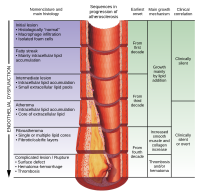
Photo from wikipedia
Objectives: The current study addressed the hypothesis that the local decrease in endothelin-1 (ET-1) bioavailability during sustained flow increases contributes to endothelium-dependent, flow-mediated dilatation (FMD) of conduit arteries and is… Click to show full abstract
Objectives: The current study addressed the hypothesis that the local decrease in endothelin-1 (ET-1) bioavailability during sustained flow increases contributes to endothelium-dependent, flow-mediated dilatation (FMD) of conduit arteries and is altered in presence of cardiovascular risk factors. Methods and results: In nine young healthy individuals, the decrease in local ET-1 plasma levels and radial artery FMD in response to hand skin heating (from 34 to 44 °C) was not affected by endothelin type A (ETA) receptor blockade, achieved using the brachial infusion of BQ-123 (100 nmol/min per l of forearm), as compared with physiological saline (0.9% NaCl) infusion. In contrast, endothelin type B (ETB) receptor blockade with BQ-788 (10 nmol/min per l) suppressed the decrease in plasma ET-1 during heating and reduced FMD, without altering nitric oxide release. The coinfusion of BQ-123 did not affect the inhibitory effect of ETB receptor blockade on the decrease in ET-1 plasma levels during heating but prevented the reduction in FMD. Basal radial artery parameters, systemic hemodynamics, and endothelium-independent dilatation to glyceryl trinitrate were not modified by ETA and/or ETB blockade. In a general population of 40 participants without treatment or major cardiovascular diseases, including the nine healthy individuals, the reduction in endothelin-1 level during heating was correlated with FMD (r = −0.55, P < 0.001) and decreased with increased age (r = 0.49, P = 0.001), mean arterial blood pressure (r = 0.48, P = 0.002), and total cholesterol level (r = 0.37, P = 0.024). Conclusion: The uptake of endothelin-1 by ETB receptors contributes to conduit artery FMD, preventing its vasoconstrictor action mediated by ETA receptors. The alteration of this mechanism by cardiovascular risk factors may contribute to endothelial dysfunction.
Journal Title: Journal of Hypertension
Year Published: 2017
Link to full text (if available)
Share on Social Media: Sign Up to like & get
recommendations!